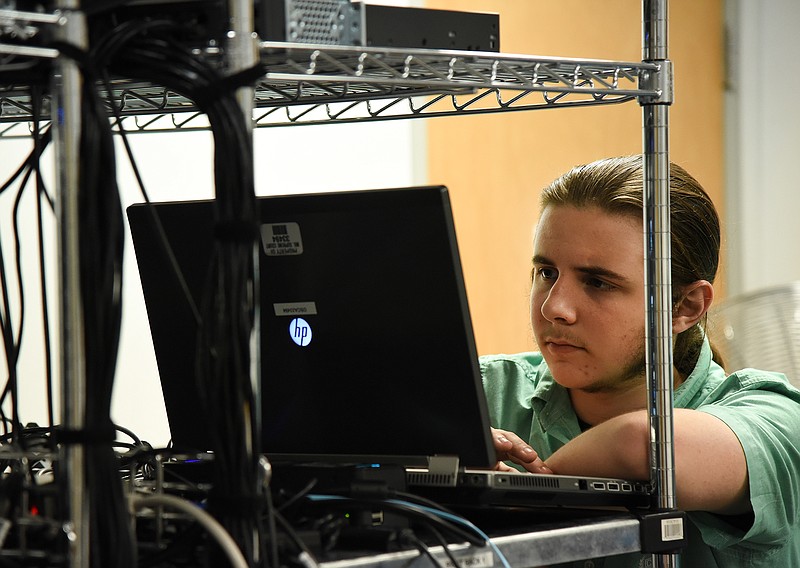As Missouri's economy heads further into the 21st century, companies of all sectors may a face crisis in the coming years.
The impending crisis: a shortage of tech industry workers.
For business leaders, the shortage already is being felt around the state.
Academia and state leaders suggest relief may be on the way. Professors at Missouri's colleges and universities said enrollment in IT programs are booming. State leaders hope changes made by a pair of task forces will prepare the state's workforce for the decades ahead.
#jcmo Inside Business
.In the modern economy, every business from financial institutions to ag businesses to manufacturers and printers need information technology specialists and computer programmers.
As manufacturing becomes more automated and the internet of things connects more things to the web, the demand for workers with computer science degrees will only continue to increase, academic sources said.
"Twenty years ago, people who worked in computer science worked for a computer company," said Shawn Berhorst, lead instructor of State Technical College's Networking System Technology Department. "Now, everybody is picking up network admins and IT people because every industry has gotten to be so data driven."
In the digital age, blue-collar jobs like auto mechanics now use technology for things like diagnostics tests, which help mechanics identify problems.
"Somebody had to design that machine and somebody has to be able to tell you what that machine finds out," said Dan Mehan, president of the Missouri Chamber of Commerce and Industry. "By necessity, the supporting cast of everything we do had to tech up because everything we use now is much more advanced now than five years ago."
Shaun Sappenfield, existing business manager at the Jefferson City Area Chamber of Commerce, said companies around the region have struggled to find tech workers for "quite some time." Sappenfield said he's sure the shortage of tech workers statewide has impacts locally, but he can't pinpoint any cases of companies being unable to conduct business.
"I'm sure it has some effects," Sappenfield said. "But I've not heard of anything that's limiting growth."
Missouri's unemployment rate stayed flat at 3.6 percent in April, the last month for which data was available as of publication. Jefferson City's unemployment rate sat lower at 2.7 percent. Companies across the region said they began to say they have trouble finding qualified job applicants in most fields months ago.
Mehan and Sappenfield said companies looking for workers in the tech industry often find themselves competing for candidates who want to move to larger cities or tech hubs like Kansas City; Austin, Texas; or Silicon Valley.
"There's just less and less opportunity in rural Missouri," Mehan said. "In general, there's just a flocking to cities."
Well-paid jobs
By and large, jobs in tech fields pay well. U.S. tech sector jobs employed 11.5 million people and had an average wage of $112,890 in 2017, according to a March study by tech trade association CompTIA.
The tech sector in Missouri's eight bordering states paid an average of $80,084, according to data from the study analyzed by the News Tribune.
Missouri's tech sector jobs employed 203,200 people in 2017. Tech jobs statewide paid an average of $88,560 in 2017, according to the report. The pay was 89 percent higher than the average for non-tech sector jobs of $46,770.
Last year, the tech industry in Missouri gained 3,630 jobs, according to the report. It was No. 19 in the nation.
Though Missouri's average tech wage of $88,560 falls about $24,000 below the national average, the national average tech wage when excluding California sits at just $102,800, according to the CompTIA report. Because the state's average pay for tech sector workers lags behind the rest of the country, Sappenfield and others said companies often pay premiums to attract workers.
"It's the chicken and egg thing," Sappenfield said of attracting workers. "If you need to fill 50 IT-related positions, that's going to have a huge impact on a company's decision whether to expand or locate in a certain location."
Tech jobs pay well, but the challenge for local leaders in the years to come will be to cultivate a workforce that likes tech at an early age, maintains that love through college, then stays in state after graduation. For students who decide to pursue computer science, Berhorst from State Tech said money may play a role, but it won't be the only factor.
"If you don't like computers, the money is not going to change that," Berhorst said.
Constantly hiring
Huber & Associates' office at 1400 Edgewood Drive employs a small army of software engineers and IT specialists. The company manages IT services for companies around the region, provides cybersecurity services and stores data in a data center in the company's basement.
Huber & Associates employs about 100 people, and about 70 percent work in technical positions. With business flourishing, the company plans to keep growing rapidly.
"We've been on a kind of constant recruitment process," said Ken Enloe, human resources director at Huber & Associates. "Over the past couple years, we've had a technology position posted pretty much consistently."
Founded in 1986, Huber & Associates now has a small satellite office in Springfield and a handful of technicians who work remotely. Enloe said Huber & Associates has hired about 25 percent of its current workforce over the last 21/2 years.
The Huber & Associates managed benefits services division serves as a contractor that provides IT services for small businesses. Enloe said the company sees this division growing well into the future, and the company may begin to expand farther into Kansas City and St. Louis.
Enloe said Huber & Associates typically finds many qualified candidates when hiring employees for entry-level jobs. Hiring for senior positions can be a challenge, though.
It's a problem shared throughout Mid-Missouri companies.
At 2505 Mission Drive in Jefferson City, the modern SSM Health St. Mary's stands as a testament to the ways technology can be integrated into modern health care.
Inside the sprawling 375,000-square-foot hospital, SSM Health doctors use technology for 3D mammograms, nuclear medicines and digital X-rays. During training exercises, technology brings mannequins in the hospital to life, giving them a pulse, a heart rate, and pupils that dilate and contract.
Surgeons at the hospital use technology to locate kidney stones, blockages in arteries, or to take fluid samples from lungs and lymph nodes without conventional surgery. Doctors use electronic medical records on a system that helps patients schedule appointments and pay bills.
"We made sure to have the latest technology around every turn," said Patrick Wood, a spokesman for SSM Health St. Mary's. "A focus on technology was critical during the planning and building phases."
With all that technology, SSM needs people to keep it running. SSM Health employs six IT employees who work with the hospital's corporate office in St. Louis. Wood said there are always challenges to finding qualified candidates in Jefferson City - no matter the profession.
Like health care, technology is transforming the city's educational institutions. Jefferson City Public Schools plans to get rid of smart boards - electronic white boards - and replace them with interactive walls - essentially wall-sized touch screens teachers and students can interact with to enhance learning.
During the upcoming school year, all Jefferson City High School students will be given Google Chromebooks to use during class. Last year, all middle school students at Lewis and Clark and Thomas Jefferson middle schools were given Chromebooks. JCPS also made Chromebooks available to every two elementary students.
The district has made significant investments over the past several years to upgrade its tech infrastructure. JCPS Chief Financial Officer Jason Hoffman said the district has 9,000 students and about 10,000 devices.
With Capital City High School being built and Jefferson City High School essentially being re-built, the district hopes its students can learn with cutting-edge technology for decades to come. Before the school district could equip its students with the technology of the future, it had to increase its focus on hiring and retaining IT workers.
Joe Martin, JCPS director of technology, said the district had trouble finding qualified candidates for a technician position it posted in late 2017. When the district did find a good applicant, sometimes the applicant's existing employer swooped in and offered a pay raise to keep him or her.
In March, the JCPS Board of Education allocated $75,000 to increase pay for existing tech support staff. For now, Martin said the district wants to make salaries more competitive just to retain its existing talent.
"It's even more difficult to compete in the government arena because private businesses can pay more," Martin said.
"Ensuring that our economy has available, productive and talented workers is the single most important factor for success in economic development,"
Training the workforce of the future
Like other companies locally, Huber & Associates typically recruits IT and other technical workers from nearby regional colleges like State Tech, Lincoln University and Missouri State University.
Code.org, a nonprofit group backed by tech companies, found, in 2017, 557,903 open computing jobs existed nationwide, but just 49,291 students graduated into the workforce.
Missouri had 11,090 open computing jobs last year but just 1,138 computer science graduates, according to the group.
In May, the Missouri Department of Economic Development launched a task force to study how the state's workforce aligns with the needs of its employers. DED Director Rob Dixon said at the time the state needs to know how it can better prepare young workers as the state's economy evolves.
"Ensuring that our economy has available, productive and talented workers is the single most important factor for success in economic development," Dixon said in a news release.
Berhorst from State Tech said the college's networking developments and application development departments have about 150 students combined. In previous years, State Tech graduated 30-40 students from the programs.
State Tech's program size has doubled over the past two years. Berhorst said the college expects to graduate 60-70 students this year. Many students find jobs working in high schools like JCHS, Berhorst said.
"The data needs of the public education system is pretty overwhelming," he said.
Like State Tech, Missouri State's computer science department is booming.
Over the past five years, the program's size has doubled and now teaches 350 students, said Lloyd Smith, a computer science professor at Missouri State.
Companies statewide still want more graduates. Neither Smith nor Berhorst expect this trend to slow any time soon.
"I still have companies calling me for graduates, and I have none left," Berhorst said.
With enrollments growing so fast, Smith said Missouri State's computer science department feels stretched thin.
"We're scrambling to teach our students, and there's a lot more that we would like to do," Smith said. "I'm sure the other universities around the state feel the same."
For the techies who lead Missouri's next generation of companies, versatility will be key. Missouri State's programs teach students two to three languages of code. Smith said the university's instructors know what they teach students could be obsolete by the middle of students' careers.
"Tech changes so fast," Smith said. "There's no way we can teach them exactly the technologies they're going to need in five years because we have no idea what those technologies are going to be."
If manufacturing jobs give way to machines, manufacturing jobs in regions like Mid-Missouri could be transformed from blue-collar to white-collar jobs. Berhorst said manufacturing jobs often employ people to program and run machines that replace humans.
"People are trying to eliminate some of their less skilled jobs and replace them with IT positions," Berhorst said. "A factory that used to have 200 people now has six IT people that make the workers there more productive."


